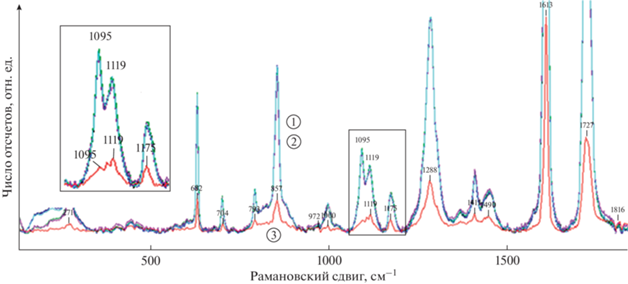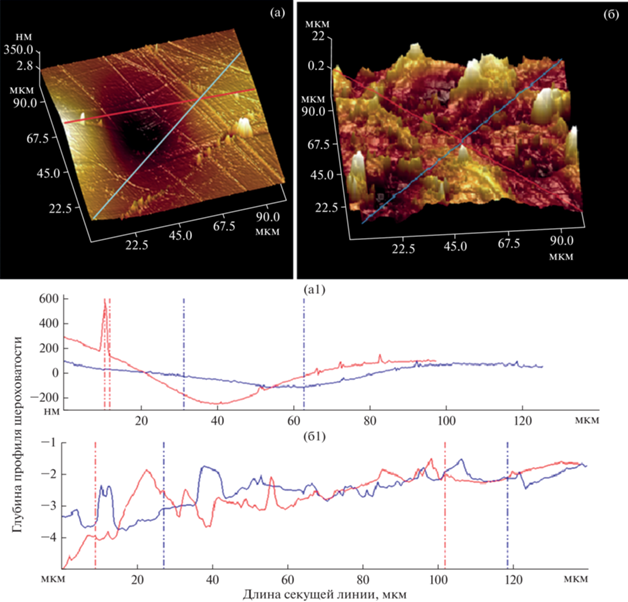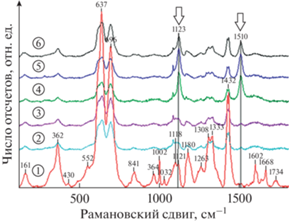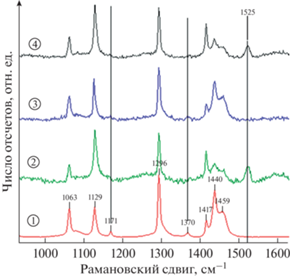Биология моря, 2023, T. 49, № 4, стр. 236-244
Оценка деградации микропластика в донных осадках с помощью рамановской микроспектроскопии и атомно-силовой микроскопии
А. А. Карпенко 1, В. С. Одинцов 1, *
1 Национальный научный центр морской биологии им. А.В. Жирмунского (ННЦМБ) ДВО РАН
690041 Владивосток, Россия
* E-mail: slavodin@inbox.ru
Поступила в редакцию 08.08.2022
После доработки 10.02.2023
Принята к публикации 30.03.2023
- EDN: UOFCZL
- DOI: 10.31857/S0134347523040058
Аннотация
Оценку деградации микропластика в донных осадках моря Лаптевых, моря Уэдделла, Чукотского моря и зал. Петра Великого Японского моря изучали с помощью рамановской микроспектроскопии и атомно-силовой микроскопии (АСМ). Степень аморфности-кристалличности полиэтилентерефталата (ПЭТ) определяли по отношению интенсивностей рамановских мод (I1095 см–1/I1115 см–1). Изменения топографии и механических свойств поверхности фрагментов полимера исследовали методами АСМ. Показано, что деградация ПЭТ, найденного в донных осадках моря Лаптевых, затрагивает преимущественно его кристаллическую фазу. Аморфная фаза ПЭТ затронута в гораздо меньшей степени или не затронута совсем. Те же изменения фазового состава поверхности ПЭТ показаны после экспозиции пластика в морском аквариуме в илистом песке из Амурского залива (зал. Петра Великого Японского моря). Данные АСМ демонстрируют увеличение шероховатости поверхности ПЭТ и уменьшение модуля упругости (модуля Юнга) в образцах из донных осадков. С помощью рамановской микроспектроскопии также показаны признаки деградации фрагментов целлофана из моря Уэдделла, поливинилхлорида (ПВХ) из моря Лаптевых и полиэтилена (ПЭ) из Амурского залива.
Широкое применение и интенсивное производство пластмасс привело к глобальному загрязнению Мирового океана полимерным мусором. Попавшие в океан пластиковые отходы постепенно уменьшаются в размере под воздействием абиотических и биотических факторов среды, что приводит к увеличению числа микрочастиц размером менее 5 мм, которые-легко потребляются гидробионтами и наносят им пока не вполне оцененный вред (Browne et al., 2011; Cedervall et al., 2012; Lusher et al., 2015; Trevail et al., 2015; Auta et al., 2017; Bergmann et al., 2017; Hermabessiere et al., 2017; Peeken et al., 2018; Haegerbaeumer et al., 2019; Kane et al., 2020; Zhang et al., 2020). Источником микропластика еще долгое время будут оставаться крупные фрагменты пластика или изделия из него, постепенно деградируя в среде и представляя долгосрочную угрозу для живых организмов и человека из-за переноса по пищевым цепям. К тому же нано- и микрочастицы пластика могут адсорбировать химические соединения, которые, концентрируясь, представляют особую опасность (Hirai et al., 2011; Webb et al., 2013).
В 2018 г. из произведенных 359 млн т пластика до 14.5 млн т поступило в океан (Wayman, Niemann, 2021). Результаты моделирования показывают, что, при условии прекращения загрязнения океана, почти весь пластик, уже имеющийся в поверхностных водах, в течение трех лет окажется на дне вследствие оседания (Koelmans et al., 2017). По этой причине вопрос разрушения полимера именно в донных осадках и на их поверхности выходит на первое место при оценке способности морских экосистем нейтрализовать его влияние. Помимо разрушения пластика под действием абиотических факторов среды, действующих на поверхности и в толще воды (свет, кислород), в донных осадках это может происходить путем биодеградации (Harrison et al., 2011; Auta, Emenike, 2017; Lwanga et al., 2018). Последнее дает основание надеяться, что процесс разрушения пластика в морских экосистемах может быть эффективнее, чем принято считать.
Цель настоящей работы – оценка деградации пластика в морских донных осадках как в естественных, так и в экспериментальных условиях.
МАТЕРИАЛ И МЕТОДИКА
В целях обнаружения пластика исследовали пробы донных осадков, собранные с разными целями в экспедициях НИС “Академик Мстислав Келдыш” в море Лаптевых и в море Уэдделла, НИС “Академик Опарин” в Чукотском море, а также в Амурском заливе (зал. Петра Великого Японского моря). Координаты мест и даты отбора проб донных осадков даны в табл. 1.
Таблица 1.
Координаты мест взятия проб донных осадков
| № станции | Дата | Широта | Долгота | Глубина, м | Орудие отбора |
|---|---|---|---|---|---|
| Море Лаптевых | |||||
| 6058 | 12.10.2018 | 76°23.76 N | 126°25.14 E | 52 | Бокскорер |
| 6065 | 13.10.2018 | 77°6.18 N | 126°25.44 E | 251 | Бокскорер |
| Чукотское море | |||||
| 4 | 19.09.2016 | 70°53.58 N | 179°54.72 W | 10 | Дночерпатель |
| 6 | 19.09.2016 | 70°31.00 N | 177°26.00 W | 50 | Дночерпатель |
| 14 | 23.09.2016 | 69°54.02 N | 171°09.46 W | 44 | Дночерпатель |
| 17 | 25.09.2016 | 67°25.70 N | 169°36.80 W | 50 | Дночерпатель |
| 18 | 25.09.2016 | 67°30.99 N | 171°21.80 W | 48 | Дночерпатель |
| 20 | 26.09.2016 | 67°32.44 N | 173°36.72 W | 42 | Дночерпатель |
| Японское море | |||||
| 1 | 18.02.2016 | 43°11.99 N | 131°54.90 E | 6 | Трубка |
| 2 | 18.02.2016 | 43°12.01 N | 131°54.90 E | 7 | Трубка |
| 3 | 18.02.2016 | 43°12.04 N | 131°54.73 E | 7.5 | Трубка |
| 4 | 18.08.2020 | 43°12.01 N | 131°54.90 E | 7 | Дночерпатель |
Пробы из моря Лаптевых (2), Чукотского моря (6), моря Уэдделла (4) и из Амурского залива (4) объемом от 120 до 1000 см3 промывали через стальное сито с размером ячеи 0.3 мм, обрабатывали в соответствии с процедурой разделения частиц с помощью раствора хлористого цинка плотностью 1.7 г/см3 (Zobkov, Esiukova, 2017). Фракцию донного осадка размером более 0.3 мм помещали в стеклянные пробирки или стаканы и заливали раствором хлористого цинка объемом, превышающим в 8–10 раз объем заливаемой фракции. Частицы, оказавшиеся на поверхности, распознавали визуально с помощью оптического микроскопа. Те из них, которые имели признаки искусственного происхождения, отбирали для дальнейшей идентификации методом рамановской микроспектроскопии.
В августе 2019 г. для исследования деградации полиэтилентерефталата в донных осадках в экспериментальных условиях несколько стандартных бутылок из ПЭТ объемом 1.5 л были заполнены морской водой и наполовину погружены в натуральный илисто-песчаный морской грунт в проточном морском аквариуме. В феврале 2020 г. одна бутылка была извлечена, отмыта от грунта и исследована методом рамановской микроспектроскопии так же, как и найденные в донных осадках фрагменты пластика.
Рамановские спектры (спектры комбинационного рассеяния) получали с помощью рамановского микроскопа-спектрометра Renishaw InVia Reflex (Renishaw, Англия), объединенного с универсальным микроскопом Leica DM 2500M (Leica Microsystems, Германия). Для возбуждения использовали диодный лазер 532 нм при мощности на уровне объекта 1.0 мВт и времени экспозиции 0.1 с в 100 повторах. Лазерное пятно диаметром около 1.65 мкм на образце формировалось объективом ×20, NA = 0.5 (Leica). Чтобы достичь минимального рамановского и флуоресцентного фона, образцы пластика помещали на алюминиевую подложку.
Для определения микромеханических характеристик пластика использован атомно-силовой микроскоп BioScope Catalyst (Bruker, США) в сочетании с инвертированным микроскопом AxioVert 200 (Carl Zeiss, Германия). Изображение получали в полуконтактном режиме Scan Asyst mode. Для контроля отсутствия разрушения образца при сканировании выборочно использовали полубесконтактный режим. Применяли кантилеверы RTESPA (k: 20–80 Н/м, f0: 318–333 кГц) и TAP 525 (k: 100–200 Н/м, f0: 534–572 кГц) (Bruker, США). Для определения модуля упругости, деформации, адгезии использовали разработанный фирмой Bruker режим наномеханического картирования (PFQNM). Перед каждым микромеханическим картированием исследуемого образца проводили калибровку датчика (кантилевера) по опорным материалам – эталонам Bruker с известными механическими свойствами поверхности: чувствительности к отклонению по лейкосапфиру, модулю упругости по полистиролу (ПС, 2.7 ГПа) и высокоориентированному пиролитическому графиту (ВОПГ, 18 ГПа). Кроме того, измеряли радиус скругления кончика иглы кантилевера на специальной тестовой пластине с покрытием из оксида титана. Полученные калибровочные данные использовались программой NanoScope v8.10 (Bruker) для расчета истинной константы упругости кантилевера при определении модуля Юнга и построения изображения объекта в микромеханических величинах (деформация упругости, адгезия). Для оценки шероховатости поверхности применяли опцию Roughness из программного пакета BioScope Catalyst (Bruker, США). Поскольку метод PFQNM позволяет получать изображения объекта в микромеханических величинах (адгезия, модуль упругости, деформация), для оценки таких данных применима та же опция Roughness.
РЕЗУЛЬТАТЫ
В двух пробах донных осадков из моря Лаптевых было обнаружено 8 фрагментов пластика размером от 1.8 × 2 до 2.5 × 4 мм, из которых 4 – ПЭТ, 3 – ПВХ и несколько фрагментов волокон длиной от 0.5 до 4 мм. Результаты исследования волокон, идентифицированных как вискоза, в данном исследовании не представлены. В пробах из моря Уэдделла обнаружена одна пластиковая частица размером 2 × 2.5 мм, оказавшаяся фрагментом целлофана. В пробах из Амурского залива обнаружен один фрагмент полиэтилена (2 × 3 мм). В пробах из Чукотского моря пластик не обнаружен.
Результат идентификационного анализа фрагмента пластика из моря Лаптевых показан на рис. 1. Соответствие пиков спектра эталонного ПЭТ и исследуемого пластика указывает на его принадлежность к ПЭТ.
Рис. 1.
Пример идентификационного анализа ПЭТ: (а) – поверхность образца полимера в падающем свете (точка сбора данных находится в перекрестии оптического прицела); (б) – рамановские спектры поверхности ПЭТ. 1 – спектр эталонного ПЭТ, 2 – усредненный спектр по 8 точкам фрагмента ПЭТ из донной пробы из моря Лаптевых. На вставке – увеличенный фрагмент отмеченных прямоугольником областей спектров для определения кристалличности образца ПЭТ по модам 1095 см–1/1115 см–1.

Основными характеристическими полосами раман-спектра ПЭТ, которые используются для установления деградации, является группа полос при 1115, 1094 и 998 см–1. Для оценки изменений кристалличности ПЭТ в этой работе использовали отношение интенсивностей мод 1094 и 1115 см–1 [I1094/I1115] (Adar, Noether, 1985; Lippert et al., 1993). На увеличенном фрагменте на рис. 1 в спектре эталонного ПЭТ (1) видно преобладание моды 1095 над 1115 см–1. Отношение интенсивностей мод I1095 см–1/I1115 см–1 = 1.42, т.е. больше 1, что свидетельствует о преобладании кристаллической фазы. Отношение интенсивностей реперных мод I1095 см–1/I1115 см–1 = 0.83 (меньше 1) в спектре 2 говорит о преобладании аморфной фазы исследуемого образца, что является признаком деградации.
Рамановские спектры пластика, эталонного и экспонированного в донных осадках в течение 6 мес в проточном аквариуме, показаны на рис. 2. Здесь четко видно, что спектры эталонного пластика (1) и экспериментального пластика, находившегося в нескольких сантиметрах (2–3 см) над грунтом (2), практически совпадают, и в них отношение интенсивностей мод I1095 см–1/I1115 см–1 больше 1. В то же время спектр части пластика, находившегося на границе раздела грунт–вода (3), характеризуется отношением интенсивностей мод I1095 см–1/I1115 см–1 (меньше 1), как и в случае с фрагментами ПЭТ из моря Лаптевых. Следовательно, фазовые изменения ПЭТ в сторону преобладания аморфности произошли на границе вода–грунт.
Рис. 2.
Рамановские спектры поверхности ПЭТ (стандартная бутылка емкостью 1.5 л) частично погруженного в грунт до и после шести месяцев экспозиции в аквариуме. На вставке представлен увеличенный фрагмент спектра с реперными модами, используемыми для оценки кристалличности полимера – 1095 и 1119 см–1. Синяя кривая (1) и зеленая кривая (2) – спектры эталонного и экспериментального ПЭТ, находившегося над грунтом, соответственно. Красная кривая (3) – спектр ПЭТ, экспонированного на границе раздела грунт–вода.

Результаты АСМ поверхности ПЭТ из моря Лаптевых показали ее существенную шероховатость по сравнению с контрольным ПЭТ (рис. 3). Шероховатость по программе Roughness (спектральная среднеквадратичная амплитуда) равнялась 3541–3698 нм и 61–135 нм соответственно (рис. 3а, 3б). Для каждого образца даны по две цифры по двум секущим (рис. 3а1, 3б1). Модуль упругости у “донного” пластика и у “свежего” ПЭТ также сильно отличались – 1.0 ± 0.1 ГПа (N = 8) и 1.7 ± 0.08 ГПа (N = 11) соответственно. Различия считались достоверными при p < 0.01.
Рис. 3.
АСМ 3D изображение поверхности ПЭТ: (а) – эталон, (б) – ПЭТ из моря Лаптевых. Сторона изображений 100 мкм. (а1), (б1) – профили поверхности образцов вдоль секущих линий, обозначенных синим и красным цветом на рисунках (а) и (б). Высоты неровностей на (а), (a1) – нм, на (б), (б1) – мкм.

На рис. 4 показаны рамановские спектры поверхности фрагмента ПВХ, обнаруженного в пробах донных осадков из моря Лаптевых. Стрелками отмечены пики полиенов в спектрах разных точек фрагмента (4, 5, 6), характерные для деградирующего ПВХ (Kuznetsov et al., 2021; Al-Dossary et al., 2010), отличающие их от эталонного спектра ПВХ (1). Отсутствие пиков 841, 964, 1002 см–1 в спектрах всех исследованных точек фрагмента также отличает его от эталонного.
Рис. 4.
Рамановские спектры поверхности ПВХ. Стрелками показаны пики полиенов, характерные для деградирующего ПВХ. 1 – эталонный спектр ПВХ; 2, 3, 4, 5, 6 – спектры разных точек фрагмента ПВХ.

В донных пробах из Амурского залива обнаружен фрагмент полиэтилена, изменения которого, по сравнению с эталонным спектром (1), явно видны на рамановских спектрах (2, 3, 4) разных точек фрагмента (рис. 5). Наличие пика в области 1525 см–1 в спектрах 2 и 4 и отсутствие пика в области 1171 см–1 в спектрах 2, 3 и 4 вместе с изменениями соотношения интенсивностей в других областях спектров говорит об изменениях поверхности полиэтилена, которые можно трактовать как деградацию.
Рис. 5.
Рамановские спектры поверхности фрагмента ПЭ: 1 – эталонный спектр полиэтилена; 2, 3, 4 – спектры разных точек фрагмента ПЭ из Амурского залива (зал. Петра Великого Японского моря).

В осадках моря Уэдделла обнаружен единственный фрагмент пластика, Рамановский спектр которого близок к спектру целлофана по ряду реперных мод (рис. 6).
ОБСУЖДЕНИЕ
Исследованные образцы пластика, найденные на дне морей, представлены не только видами с плотностью выше, чем у морской воды, – ПВХ, ПЭТ, целлофан, но и более легкими, такими как полиэтилен. Если допустить, что разные виды пластика попадают в океан пропорционально производимым объемам и сохраняют плавучесть, то около половины должно оседать на дно, а вторая половина – плавать на поверхности в соответствии с плотностью по отношению к плотности морской воды. Однако на скопления на поверхности моря приходится примерно лишь 1% от предполагаемого глобального морского пластикового загрязнения. Большая часть недостающих 99% пластика попадает в морские глубины (Koelmans et al., 2017; Barrett et al., 2020; Kane et al., 2020). По-видимому, это связано с тем, что легкие пластики обрастают микроорганизмами, поглощаются гидробионтами и теряют плавучесть. Это трудно количественно оценить, но логично предположить, что любой пластик в конце концов должен оказаться на дне, если не успел деградировать в толще воды и на ее поверхности до степени летучих или растворимых соединений. Именно поэтому исследования процессов трансформации пластика в донных осадках и потенциальной опасности продуктов его распада для животных и человека представляются более важными, чем изучение распределения пластика в океане. Распределение макропластика (>5 мм) и микропластика (335 мкм–5 мм) не может быть адекватно измерено с помощью доступных в настоящее время методов. Кроме того, для пластиковых частиц размером менее 0.335 мм пока не существует способов систематической оценки их массового распределения в океане (Koelmans et al., 2017).
При изучении деградации и биодеградации пластика важным вопросом является определение ее признаков и критериев оценки. Разные исследователи подходят к этому вопросу по-разному. Некоторые авторы отслеживают деградацию, регистрируя потерю массы микропластика и характер роста микроорганизмов в минеральной среде или оценивая морфологические и структурные изменения пластика с помощью сканирующей электронной микроскопии и инфракрасной спектроскопии (Auta et al., 2017). Другие оценивают биодеградацию по изменению молекулярной массы пластика (Zhang et al., 2020). Признавая любые способы объективного контроля, авторы настоящей работы полагают, что изменения химического состава и механических характеристик микропластика являются наиболее значимыми при оценке деградации вообще и биодеградации в частности.
По этой причине нами были выбраны методы, позволяющие оценить изменения топографии и механических свойств поверхности пластиковых частиц, а также химической структуры, отраженной в рамановских спектрах неупругого рассеяния.
Как показатель изменения кристалличности ПЭТ мы использовали отношения интенсивностей между полосами при 1094 и 1115 см–1 (I1094/I1115), которые представляют относительную концентрацию трансгликолевых конформеров (Fechine et al., 2002; Lin et al., 2016). По нашим данным, уменьшение доли кристаллической фазы полимера, определяемое по уменьшению соотношения интенсивностей реперных мод (I1095 см–1/I1115 см–1), – верный признак начала деградации материала. То, что разрушение образцов ПЭТ характеризуется уменьшением их кристалличности, показано по результатам исследования и пластика из моря Лаптевых (рис. 1), и пластика, выдержанного в условиях аквариума (рис. 2). Это соответствует данным Лин с соавторами (Lin et al., 2016) показавшими, что более низкое отношение интенсивности I1094/I1115 обычно соответствует более низкой кристалличности. Подобные результаты получены и другими авторами, которые обнаружили, что отношение I1094/I1115 уменьшается от объема к открытой поверхности ПЭТ во внешнем слое. Это позволяет предположить, что кристалличность ПЭТ вблизи поверхности становится ниже после старения (Fechine et al., 2002; Planes et al., 2014). Интересно, что изменения поверхности пластика, связаные с изменением кристалличности ПЭТ в аквариальных условиях, наблюдались на границе грунт–вода. Над поверхностью грунта изменений в фазовом составе поверхности ПЭТ не зафиксировано (рис. 2).
Стоит отметить, что уменьшение кристалличности ПЭТ со временем согласуется не со всеми опубликованными результатами. Есть данные, что биодеградация ПЭТ характеризуется изменением фазового состава пластика в сторону увеличения его кристалличности, т.е. аморфная фаза ПЭТ прогрессивно уменьшается под действием бактериальных ферментов (эстеразы, липазы, ПЭТазы) (Webb et al., 2013; Danso et al., 2018; Hiraga et al., 2019). Результаты исследования пластика методами атомно-силовой микроскопии подтверждают наши выводы о преобладании аморфной фазы в деградирующем пластике. Модуль Юнга у пластика из моря Лаптевых ниже, чем у свежего ПЭТ (1.1 и 1.7 ГПа соответственно). Также поверхность ПЭТ из моря Лаптевых по сравнению с поверхностью эталонного полиэтилентерефталата отличается существенной шероховатостью (рис. 3). Эти данные АСМ свидетельствуют в пользу существенной деградации поверхности у пластика из донных осадков притом, что на глубине исключено влияние ультрафиолетового излучения, а мягкие грунты и слабая гидродинамика не способствуют механическому измельчению пластика при контакте с твердыми частицами.
Результат исследования ПВХ, показавший наличие в нем полиенов (рис. 4), говорит о деградации найденного в море пластика, однако у поливинилхлорида сопряженные двойные связи и полиеновые последовательности в рамановских спектрах появляются под действием температуры или ультрафиолетового излучения (Al-Dossary et al., 2010; Kuznetsov et al., 2021). По этой причине мы не можем утверждать, что исследованный ПВХ получил такие изменения после того, как попал в море. Если для ПЭТ показаны признаки деградации при экспозиции в донных осадках, то вопрос деградации ПВХ в природной среде в отсутствие света и экстремальных температур нуждается в дополнительных исследованиях.
В отличие от полиэтилентерефталата, в рамановском спектре полиэтилена к кристаллической фазе относится область моды 1418 см–1, а моды 1439 и 1462 см–1 отмечают его аморфную фазу (Hiejima et al., 2018). В спектрах полиэтилена 2 и 4 (рис. 5) из Амурского залива мода в области 1418 см–1 по интенсивности явно выше мод, соответствующих его аморфной фазе (1439 и 1462 см–1). Вместе с появлением пиков 1525 см–1 в спектрах 2 и 4 (рис. 5), отсутствующих в спектре эталонного полиэтилена (спектр 1, рис. 5), это свидетельствует об изменении фазового состава полиэтилена по сравнению с эталонным пластиком, т.е. является дополнительным признаком его деградации (Hiejima et al., 2018).
Исследование фрагмента из моря Уэдделла выявило некоторые трудности идентификации пластика с помощью рамановской микроспектроскопии при отсутствии библиотеки спектров всех возможных продуктов его трансформации и деградации. Спектр найденного фрагмента более всего соответствует эталонному целлофану (рис. 6). При этом отсутствие мод 1264 и 1310 см–1 может говорить о его деградации.
В заключение следует отметить, что рамановская спектроскопия показывает текущее состояние иногда настолько измененного пластика, что исходный фрагмент трудно идентифицировать даже при наличии эталонных образцов. Важной задачей остается также идентификация продуктов трансформации пластика и оценка скорости его деградации с выявлением реальных факторов, влияющих на этот процесс. В решении этих проблем несомненное преимущество имеет экспериментальный подход к исследованию трансформации пластика с моделированием воздействующих на него биотических и абиотических факторов среды. Например, экспериментальное изучение деградации пластика в пищеварительной системе литторин не оставляет сомнений в биологической природе полученных изменений микропластика, т.е. биодеградации (Odintsov et al., 2022).
Список литературы
Adar F., Noether H. Raman microprobe spectra of spin-oriented and drawn filaments of poly(ethylene terephtha-late) // Polymer. 1985. V. 26. № 13. P. 1935–1943.
Al-Dossary A.K., Gilbert M., Hitt D. Evaluating PVC degradation using UV and Raman spectroscopies // Advanced Materials Research. 2010. V. 83–86. P. 923–930. https://doi.org/10.4028/www.scientific.net/AMR.83-86.923
Auta H.S., Emenike C.U. Screening of Bacillus strains isolated from mangrove ecosystems in Peninsular Malaysia for microplastic degradation // Environ. Pollut. 2017. V. 231. № 2. P. 1552–1559. https://doi.org/10.1016/j.envpol.2017.09.043
Auta H.S., Emenike C.U., Fauziah S.H. Distribution and importance of microplastics in the marine environment: a review of the sources, fate, effects, and potential solutions // Environ. Int. 2017. V. 102. P. 165–176.https://doi.org/10.1016/j.envint.2017.02.013
Barrett J., Chase Z., Zhang J. et al. Microplastic Pollution in Deep-Sea Sediments From the Great Australian Bight // Front. Mar. Sci. 2020. V. 7. 576170. https://doi.org/10.3389/fmars.2020.576170
Bergmann M., Wirzberger V., Krumpen T. et al. High quantities of microplastic in Arctic deep-sea sediments from the HAUSGARTEN observatory // Environ. Sci. Technol. 2017. V. 51. № 19. P. 11000–11010. https://doi.org/10.1021/acs.est.7b03331
Browne M.A., Crump P., Niven S.J. et al. Accumulation of microplastic on shorelines woldwide: sources and sinks // Environ. Sci. Technol. 2011. V. 45. № 21. P. 9175–9179. https://doi.org/10.1021/es201811s
Cedervall T., Hansson L.-A., Lard M. et al. Food chain transport of nanoparticles affects behaviour and fat metabolism in fish // PLoS One. 2012. V. 7. № 2. e32254. https://doi.org/10.1371/journal.pone.0032254
Danso D., Schmeisser C., Chow J. et al. New insights into the function and global distribution of polyethylene terephthalate (PET) – degrading bacteria and enzymes in marine and terrestrial metagenomes // Appl. Environ. Microbiol. 2018. V. 84. e02773-02717. https://doi.org/10.1128/AEM.02773-17
Fechine G.J.M., Rabello M.S., Souto-Maior R.M. The effect of ultraviolet stabilizers on the photodegradation of poly(ethylene terephthalate) // Polymer Degradation and Stability. 2002. V. 75. № 1. P. 153–159. https://doi.org/10.1016/s0141-3910(01)00214-2
Haegerbaeumer A., Mueller M.-T., Fueser H., Traunspurger W. Impacts of Micro- and Nano-Sized Plastic Particles on Benthic Invertebrates: A Literature Review and Gap Analysis // Front. Environ. Sci. 2019. V. 7. № 17. https://doi.org/10.3389/fenvs.2019.00017
Harrison J.P., Sapp M., Schratzberger M., Osborn A.M. Interactions Between Microorganisms and Marine Microplastics: A Call for Research // Mar. Technol. Soc. J. 2011. V. 45. № 2. P. 12–20. https://doi.org/10.4031/MTSJ.45.2.2
Hiejima Y., Kida T., Takeda K. et al. Microscopic structural changes during photodegradation of low-density polyethylene detected by Raman spectroscopy // Polymer Degradation and Stability. 2018. V. 150. P. 67–72. https://doi.org/10.1016/j.polymdegradstab.2018.02.010
Hermabessiere L., Dehaut A., Paul-Pont I. et al. Occurrence and effects of plastic additives on marine environments and organisms: a review // Chemosphere. 2017. V. 182. P. 781–793. https://doi.org/10.1016/j.chemosphere.2017.05.096
Hiraga K., Taniguchi I., Yoshida S. et al. Biodegradation of waste PET: A sustainable solution for dealing with plastic pollution // EMBO reports. 2019. V. 20. № 11. P. e49365. https://doi.org/10.15252/embr.201949365
Hirai H., Takada H., Ogata Y. et al. Organic micropollu-tants in marine plastics debris from the open ocean and remote and urban beaches // Mar. Pollut. Bull. 2011. V. 62. № 8. P. 1683–1692. https://doi.org/10.1016/j.marpolbul.2011.06.004
Kane I.A., Clare M.A., Miramontes E. et al. Seafloor microplastic hotspots controlled by deep-sea circulation // Science. 2020. V. 368 (6495). https://doi.org/10.1126/science.aba5899
Koelmans A.A., Kooi M., Law K.L., van Sebille E. All is not lost: Deriving a top-down mass budget of plastic at sea // Environ. Res. Lett. 2017. V. 12. 114028. https://doi.org/10.1088/1748-9326/aa9500
Kuznetsov S.M., Sagitova E.A., Prokhorov K.A. et al. Raman spectroscopic detection of polyene-length distribution for high-sensitivity monitoring of photo- and thermal degradation of polyvinylchloride // Spectrochimica Acta. Part A: Molecular and Biomolecular Spectroscopy. 2021. V. 252. 119494. https://doi.org/10.1016/j.saa.2021.119494
Lin C.C., Krommenhoek P.J., Watson S.S. et al. Depth profiling of degradation of multilayer photovoltaic backsheets after accelerated laboratory weathering: Cross-sectional Raman imaging // Solar Energy Materials and Solar Cells. 2016. V. 144. P. 289–299.
Lippert T., Zimmermann F., Wokaun A. Surface analysis of excimer-laser- treated polyethylene-terephthalate by surface-enhanced Raman scattering and X-ray photo electron spectroscopy // Appl.Spectrosc. 1993. V. 47. P. 1931–1942.
Lusher A.L., Tirelli V., O’Connor I. et al. Microplastics in Arctic polar waters: the first reported values of particles in surface and sub-surface samples // Scientific reports. 2015. V. 5. P. 14947. https://doi.org/10.1038/srep14947
Lwanga E.H., Thapa B., Yang X. et al. Decay of low-density polyethylene by bacteria extracted from earthworm’s guts: A potential for soil restoration // Sci. Total Environ. 2018. V. 624. P. 753–757. https://doi.org/10.1016/j.scitotenv.2017.12.144
Odintsov V.S., Karpenko A.A., Karpenko M.A. Degradation of micro‑nano‑sized polytetrafluoroethylene and acrylic fluorinated copolymer particles in the periwinkle digestive tract // Environ. Sci. Pollut. Res. Int. 2022. https://doi.org/10.1007/s11356-022-23996-5
Peeken I., Primpke S., Beyer B. et al. Arctic sea ice is an important temporal sink and means of transport for microplastic // Nature communications. 2018. V. 9. № 1. P. 1–12. https://doi.org/10.1038/s41467-018-03825-5
Planes E., Yrieix B., Bas C. et al. Chemical degradation of the encapsulation system in flexible PV panel as revealed by infrared and Raman microscopies // Solar Energy Materials and Solar Cells. 2014. V. 122. P. 15–23.
Trevail A.M., Gabrielsen G.W., Kühn S. et al. Elevated levels of ingested plastic in a high Arctic seabird, the northern fulmar (Fulmarus glacialis) // Polar Biology. 2015. V. 38. № 7. P. 975–981. https://doi.org/10.1007/s00300-015-1657-4
Webb H.K., Arnott J., Crawford R.J. et al. Plastic degradation and its environmental implications with special refe-rence to poly(ethylene terephthalate) // Polymers. 2013. V. 5. № 1. P. 1–18. https://doi.org/10.3390/polym5010001
Wayman C., Niemann H. The fate of plastic in the ocean environment – a minireview // Environ. Sci.: Processes Impacts. 2021. V. 23. 198–212. https://doi.org/10.1039/d0em00446d
Zhang J., Zhao Y., Li L. et al. Biodegradation of polye-thylene microplastic particles by the fungus Aspergillus flavus from the guts of wax moth Galleria mellonella // Sci. Total. Environ. 2020. V. 704. 135931. https://doi.org/10.1016/j.scitotenv.2019.135931
Zobkov M., Esiukova E. Microplastics in Baltic bottom se-diments: Quantification procedures and first results // Marine Pollution Bulletin. 2017. V. 114. P. 724–732. https://doi.org/10.1016/j.marpolbul.2016.10.060
Дополнительные материалы отсутствуют.



